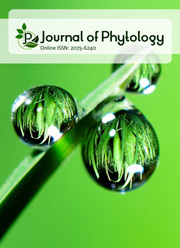Environmental and spectroscopic approaches to lead ion detection using Schiff base in arid and semi-arid zones
DOI:
https://doi.org/10.25081/jaa.2025.v11.9627Keywords:
Arid and semi-arid soil, Lead ion, Chemosensor, Schiff baseAbstract
A novel colorimetric chemosensor, (E)-2-methoxy-3-((naphthalen-1-ylamino)methylene)chroman-4-one (FCNA), has been successfully developed for the selective detection of lead (Pb²⁺) ions in environmental soil samples such as those from arid land and semi-arid land. This sensor exhibits high sensitivity and selectivity, with a low detection limit of 5.24×10-10 M and an association constant of 3.22×105 M-1, confirming its strong binding affinity toward Pb²⁺ ions. Structural analysis via FTIR, NMR, and Job’s plot suggests the formation of stable 2:1 complex between FCNA and Pb²⁺, reinforcing its specificity. The ease of synthesis and robust selectivity make FCNA an ideal candidate for Pb²⁺ ions detection, particularly in environmental soil monitoring. Real sample analysis was conducted to validate its performance, demonstrating high reliability in detecting Pb²⁺ ions in complex matrices. Given its exceptional detection ability, FCNA emerges as a promising tool for heavy metal ion monitoring, supporting environmental safety assessments and pollution control efforts in soils.
Downloads
References
Amini, A., Rahimi, M., Behmadi, H., Nazari, M., Benson, V., Cheng, C., & Samali, B. (2020). 2,6-Pyridinedicarbohydrazide-salicylal hydrazone-base derivative with high detection limit and binding constant for emissive ion chemosensing in aqueous solution. Journal of Photochemistry and Photobiology A: Chemistry, 392, 112344. https://doi.org/10.1016/j.jphotochem.2019.112344
Burla, S. R., Patil, D. B., Mohana Rao, P., & Jayalakshmi, M. (2013). Delineation of copper (Cu) and zinc (Zn) status in soils of central research station akola. Journal of Progressive Agriculture, 4(1), 131-134.
Caballero, A., Espinosa, A., Tárraga, A., & Molina, P. (2008). Ferrocene-based small molecules for dual-channel sensing of heavy- and transition-metal cations. The Journal of Organic Chemistry, 73(14), 5489-5497. https://doi.org/10.1021/jo800709v
Cave, M. R., Butler, O., Cook, J. M., Cresser, M. S., Garden, L. M., & Miles, D. L. (2000). Environmental analysis. Journal of Analytical Atomic Spectrometry, 15(2), 181-235. https://doi.org/10.1039/b000063i
Chen, C.-T., & Huang, W.-P. (2002). A highly selective fluorescent chemosensor for lead ions. Journal of the American Chemical Society, 124(22), 6246-6247. https://doi.org/10.1021/ja025710e
Cho, H., Chae, J. B., & Kim, C. (2018). A thiophene-based blue-fluorescent emitting chemosensor for detecting indium (III) ion. Inorganic Chemistry Communications, 97, 171-175. https://doi.org/10.1016/j.inoche.2018.09.037
Choi, J. H., Ryu, J. Y., Park, Y. J., Begum, H., Park, H.-R., Cho, H. J., Kim, Y., & Lee, J. (2014). Fluorescent chemosensor based on pyrrole-aminoindanol for selective zinc detection. Inorganic Chemistry Communications, 50, 24-27. https://doi.org/10.1016/j.inoche.2014.10.007
Divya, D., & Thennarasu, S. (2020). A novel isatin-based probe for ratiometric and selective detection of Hg2+ and Cu2+ ions present in aqueous and environmental samples. Spectrochimica Acta Part A: Molecular and Biomolecular Spectroscopy, 243, 118796. https://doi.org/10.1016/j.saa.2020.118796
Durgaparameshwari, M., Kaviya, K., Prabakaran, D. S., Santhamoorthy, M., Rajamanikandan, R., Al‐Ansari, M. M., & Mani, K. S. (2024). Designing a simple quinoline‐based chromo‐fluorogenic receptor for highly specific quantification of copper (II) ions: Environmental and bioimaging applications. Luminescence, 39(12), e70068. https://doi.org/10.1002/bio.70068
Dwivedi, R., Singh, S., Chauhan, B. S., Srikrishna, S., Panday, A. K., Choudhury, L. H., & Singh, V. P. (2020). Aroyl hydrazone with large Stokes shift as a fluorescent probe for detection of Cu2+ in pure aqueous medium and in vivo studies. Journal of Photochemistry and Photobiology A: Chemistry, 395, 112501. https://doi.org/10.1016/j.jphotochem.2020.112501
Elkhatib, E. A., & Moharem, M. L. (2015). Immobilization of copper, lead, and nickel in two arid soils amended with biosolids: Effect of drinking water treatment residuals. Journal of Soils and Sediments, 15, 1937-1946. https://doi.org/10.1007/s11368-015-1127-1
Hussain, Z., Bharathamani, D. K., & Subban, R. (2025). Detection of copper ions in arid and semi-arid lands using UV-visible and fluorescence spectrophotometry. Journal of Aridland Agriculture, 11, 54-61. https://doi.org/10.25081/jaa.2025.v11.9525
Joshi, D. C. (2016). Adsorption and desorption of copper by calcareous arid soils. Annals of Arid Zone, 34(4), 253-257.
Kuo, W.-J., Chen, Y.-H., Jeng, R.-J., Chan, L.-H., Lin, W.-P., & Yang, Z.-M. (2007). Peripheral aryl-substituted pyrrole fluorophores for glassy blue-light-emitting diodes. Tetrahedron, 63(30), 7086-7096. https://doi.org/10.1016/j.tet.2007.05.032
Lan, L., Niu, Q., Guo, Z., Liu, H., & Li, T. (2017). Highly sensitive and fast responsive “turn-on” fluorescent sensor for selectively sensing Fe3+ and Hg2+ in aqueous media based on an oligothiophene derivative and its application in real water samples. Sensors and Actuators B: Chemical, 244, 500-508. https://doi.org/10.1016/j.snb.2017.01.042
Leslee, D. B. C., Karuppannan, S., Karmegam, M. V., Gandhi, S., & Subramanian, S. (2018). A fluorescent turn-on carbazole-rhodanine based sensor for detection of Ag+ ions and application in Ag+ ions imaging in cancer cells. Journal of Fluorescence, 29, 75-89. https://doi.org/10.1007/s10895-018-2312-6
Li, X., Feng, S.-S., Wei, Y.-X., & Dong, W.-K. (2022). An investigation of a relatively rigid acyclic salamo-type ligand and its square planar Cu(II) complex. Journal of Coordination Chemistry, 75(15-16), 2245-2257. https://doi.org/10.1080/00958972.2022.2123738
Łukasik, N., Wagner-Wysiecka, E., Hubscher-Bruder, V., Michel, S., Bocheńska, M., & Kamińska, B. (2016). Naphthyl- vs. anthrylpyridine-2,6-dicarboxamides in cation binding studies. Synthesis and spectroscopic properties. Supramolecular Chemistry, 28(7-8), 673-685. https://doi.org/10.1080/10610278.2015.1119830
Maloney, B., Bayon, B. L., Zawia, N. H., & Lahiri, D. K. (2018). Latent consequences of early-life lead (Pb) exposure and the future: Addressing the Pb crisis. NeuroToxicology, 68, 126-132. https://doi.org/10.1016/j.neuro.2018.06.016
Maurya, N., & Singh, A. K. (2017). Indirect approach for CN− detection via Cu2+ induced turn-off sensor: Using novel AIEE fluorophore with logic gate and antimicrobial application. Dyes and Pigments, 147, 484-490. https://doi.org/10.1016/j.dyepig.2017.08.046
Novikov, A. S. (2022). Non-covalent interactions in coordination and organometallic chemistry. Crystals, 10(6), 537. https://doi.org/10.3390/cryst10060537
Pothulapadu, C. A. S., Jayaraj, A., Swathi, N., Priyanka, R. N., & Sivaraman, G. (2021). Novel benzothiazole-based highly selective ratiometric fluorescent Turn-On sensors for Zn2+ and colorimetric chemosensors for Zn2+, Cu2+, and Ni2+ ions. ACS Omega, 6(38), 24473-24483. https://doi.org/10.1021/acsomega.1c02855
Prabhu, J., Velmurugan, K., & Nandhakumar, R. (2015). Development of fluorescent lead II sensor based on an anthracene derived chalcone. Spectrochimica Acta Part A: Molecular and Biomolecular Spectroscopy, 144, 23-28. https://doi.org/10.1016/j.saa.2015.02.028
Rahimi, H., Hosseinzadeh, R., & Tajbakhsh, M. (2020). A new and efficient pyridine-2,6-dicarboxamide-based fluorescent and colorimetric chemosensor for sensitive and selective recognition of Pb2+ and Cu2+. Journal of Photochemistry and Photobiology A: Chemistry, 407, 113049. https://doi.org/10.1016/j.jphotochem.2020.113049
Rasmussen, S. C., Evenson, S. J., & McCausland, C. B. (2015). Fluorescent thiophene-based materials and their outlook for emissive applications. Chemical Communications, 51(22), 4528-4543. https://doi.org/10.1039/c4cc09206f
Roy, A., Shee, U., Mukherjee, A., Mandal, S. K., & Roy, P. (2019). Rhodamine-based dual chemosensor for Al3+ and Zn2+ ions with distinctly separated excitation and emission wavelengths. ACS Omega, 4(4), 6864-6875. https://doi.org/10.1021/acsomega.9b00475
Rupa, S. A., Moni, M. R., Patwary, M. A. M., Mahmud, M. M., Haque, M. A., Uddin, J., & Abedin, S. M. T. (2022). Synthesis of novel tritopic hydrazone ligands: spectroscopy, biological activity, DFT, and molecular docking studies. Molecules, 27(5), 1656. https://doi.org/10.3390/molecules27051656
Santhamoorthy, M., Mani, K. S., Periyasami, G., Kim, S.-C., Mohan, A., & Phan, T. T. V. (2024). Synthesis and surface modifications of mesoporous silica adsorbent for selective removal of chromium (Cr3+) ions from wastewater. Separation Science and Technology, 59(4), 547-560. https://doi.org/10.1080/01496395.2024.2335345
Shoora, S. K., Jain, A. K., & Gupta, V. K. (2015). A simple Schiff base based novel optical probe for aluminium (III) ions. Sensors and Actuators B: Chemical, 216, 86-104. https://doi.org/10.1016/j.snb.2015.04.038
Suaad, K. A., Zeina Gany, F., & Sherin Mohammed, M. (2020). Determination of copper and lead in soil samples and cultivated plants in Al-muradiya area, Iraq. Plant Archives, 20(2), 7461-7464.
Sun, T., Niu, Q., Li, Y., Li, T., & Liu, H. (2017). Novel oligothiophene-based dual-mode chemosensor: “naked-eye” colorimetric recognition of Hg2+ and sequential off-on fluorescence detection of Fe3+ and Hg2+ in aqueous media and its application in practical samples. Sensors and Actuators B: Chemical, 248, 24-34. https://doi.org/10.1016/j.snb.2017.03.128
Sun, X., Wang, Y.-W., & Peng, Y. (2012). A selective and ratiometric bifunctional fluorescent probe for Al3+ ion and proton. Organic Letters, 14(13), 3420-3423. https://doi.org/10.1021/ol301390g
Tahmasebi, E., Masoomi, M. Y., Yamini, Y., & Morsali, A. (2014). Application of mechanosynthesized azine-decorated zinc(II) metal–organic frameworks for highly efficient removal and extraction of some heavy-metal ions from aqueous samples: A comparative study. Inorganic Chemistry, 54(2), 425-433. https://doi.org/10.1021/ic5015384
Torawane, P., Tayade, K., Bothra, S., Sahoo, S. K., Singh, N., Borse, A., & Kuwar, A. (2015). A highly selective and sensitive fluorescent ‘turn-on’ chemosensor for Al3+ based on CN isomerisation mechanism with nanomolar detection. Sensors and Actuators B: Chemical, 222, 562-566. https://doi.org/10.1016/j.snb.2015.08.104
Udhayakumari, D., & Velmathi, S. (2013). Colorimetric chemosensor for multi-signaling detection of metal ions using pyrrole based Schiff bases. Spectrochimica Acta Part A: Molecular and Biomolecular Spectroscopy, 122, 428-435. https://doi.org/10.1016/j.saa.2013.11.083
Velmathi, S., Reena, V., Suganya, S., & Anandan, S. (2011). Pyrrole based Schiff bases as colorimetric and fluorescent chemosensors for fluoride and hydroxide anions. Journal of Fluorescence, 22, 155-162. https://doi.org/10.1007/s10895-011-0942-z
Wang, A., Fan, R., Dong, Y., Song, Y., Zhou, Y., Zheng, J., Du, X., Xing, K., & Yang, Y. (2017a). Novel hydrogen-bonding cross-linking aggregation-induced emission: water as a fluorescent “ribbon” detected in a wide range. ACS Applied Materials & Interfaces, 9(18), 15744-15757. https://doi.org/10.1021/acsami.7b01254
Wang, A., Fan, R., Wang, P., Fang, R., Hao, S., Zhou, X., Zheng, X., & Yang, Y. (2017b). Research on the mechanism of aggregation-induced emission through supramolecular metal–organic frameworks with mechanoluminescent properties and application in press-jet printing. Inorganic Chemistry, 56(21), 12881-12892. https://doi.org/10.1021/acs.inorgchem.7b01687
Wang, Y., Mao, P.-D., Wu, W.-N., Mao, X.-J., Fan, Y.-C., Zhao, X.-L., Xu, Z.-Q., & Xu, Z.-H. (2017c). New pyrrole-based single-molecule multianalyte sensor for Cu2+, Zn2+, and Hg2+ and its AIE activity. Sensors and Actuators B: Chemical, 255, 3085-3092. https://doi.org/10.1016/j.snb.2017.09.133
Xiang, Y., Tong, A., Jin, P., & Ju, Y. (2006). New fluorescent rhodamine hydrazone chemosensor for Cu(II) with high selectivity and sensitivity. Organic Letters, 8(13), 2863-2866. https://doi.org/10.1021/ol0610340
Published
How to Cite
Issue
Section
Copyright (c) 2025 P. Nivetha, S. Abinaya, A. Thangamani

This work is licensed under a Creative Commons Attribution-NonCommercial 3.0 Unported License.





 .
.